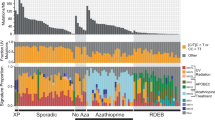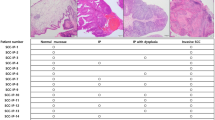Summary
To understand the role of p53 tumour suppressor gene in the carcinogenesis of arsenic-related skin cancers from the blackfoot disease endemic area of Taiwan, we collected tumour samples from 23 patients with Bowen’s disease, seven patients with basal cell carcinomas (BCC) and nine patients with squamous cell carcinomas (SCC). The result showed that p53 gene mutations were found in 39% of cases with Bowen’s disease (9/23), 28.6% of cases with BCC (2/7) and 55.6% of cases with SCC (5/9). Most of the mutation sites were located on exon 5 and exon 8. Moreover, the results from direct sequencing indicated that missense mutations were found at codon 149 (C→T) in one case, codon 175 (G→A) in three cases, codon 273 (G→C) in three cases, codon 292 (T→A) in one case, codon 283 (G→T) in one case, codon 172 (T→C) in one case and codon 284 (C→A) in one case. In addition, silent mutations were also found in four cases. These mutations were located at codons 174, 253, 289 and 298 respectively. In immunohistochemistry analysis, p53 overexpression was found in 43.5% (10/23) of cases with Bowen’s disease, 14% (1/7) of cases with BCC and 44% (4/9) of cases with SSC. These findings showed that p53 gene mutation rate in arsenic-related skin cancers from the blackfoot disease endemic area of Taiwan is high and that the mutation types are different from those in UV-induced skin cancers.
Similar content being viewed by others
Article PDF
Change history
16 November 2011
This paper was modified 12 months after initial publication to switch to Creative Commons licence terms, as noted at publication
References
Berg, R. J., van Kranen, H. J., Rebel, H. G., de Vries, A., van Vloten, W. A., Van Kreijl, C. F., van der Leun, J. C. & de Gruijl, F. R. (1996). Early p53 alteration in mouse skin carcinogenesis by UVB radiation: immunohistochemical detection of mutant p53 protein in clusters of preneoplastic epidermal cells. Proc Natl Acad Sci USA 93: 274–278.
Bishop, J. M. (1991). Molecular themes in oncogenesis. Cell 64: 235–248.
Brash, D. E., Rudolph, J. A., Simon, J. A., Lin, A., McKenna, G. J., Baden, H. P., Halperin, A. J. & Ponten, J. (1991). A role for sunlight in skin cancer: UV-induced p53 mutations in squamous cell carcinoma. Proc Natl Acad Sci USA 88: 1012–1018.
Brown, K. G. & Chen, C. J. (1995). Significance of exposure assessment to analysis of cancer risk from inorganic arsenic in drinking water in Taiwan. Risk Anal 15: 475–484.
Cavigelli, M., Li, W. W., Lin, A., Su, B., Yoshioka, K. & Karin, M. (1996). The tumor promoter arsenite stimulates AP-1 activity by inhibiting JNK phosphatase. EMBO J 15: 6269–6279.
Chen, C. J., Wu, M., Lee, S. S., Wang, J. D., Cheng, S. H. & Wu, H. Y. (1988). Atherogenicity and carcinogenicity of high-arsenic artesian well water. Multiple risk factors and related malignant neoplasms of blackfoot disease. Arteriosclerosis 8: 452–460.
Chiang, H. A., Guo, H. R., Hong, C. L., Lin, S. M. & Lee, E. F. (1993). The incidence of bladder cancer in black foot disease endemic area in Taiwan. Br J Urol 71: 274–278.
Chiou, H. Y., Hsueh, Y. M., Liaw, K. F., Horng, S. F., Chiang, M. H., Pu, Y. S., Lin, J. S., Huang, C. H. & Chen, C. J. (1995). Incidence of internal cancers and ingested inorganic arsenic: a seven-year follow-up study in Taiwan. Cancer Res 55: 1296–1300.
Debec, C., Courgeon, A. M., Mainground, M. & Maisonhaute, C. (1990). The response of the centrosome to heat shock and related stresses in a Drosophila cell line. J Cell Sci 96: 403–412.
Drouin, R. & Therrien, J. P. (1997). UVB-induced cyclobutane pyrimidine dimer frequency correlates with skin cancer mutational hotspots in p53. Protochem Photobiol 66: 719–726.
Hsueh, Y. M., Cheng, G. S., Wu, M. M., Yu, H. S., Kuo, T. L. & Chen, C. J. (1995). Multiple risk factors associated with arsenic-induced skin cancer, effects of chronic liver disease and malnutritional status. Br J Cancer 7: 109–114.
Hsueh, Y. M., Huang, C. C., Wu, W. L., Chen, H. M., Yang, M. H., Lue, L. C. & Chen, C. J. (1998). Urinary levels of inorganic and organic arsenic metabolites among residents in arseniasis-hyperendemic area in Taiwan. J Toxicol Environ Health 54: 431–444.
Inga, A., Scott, G., Monti, P., Aprile, A., Abbondandolo, A., Burns, P. A. & Fronza, G. (1998). Ultraviolet-light induced p53 mutational spectrum in yeast is indistinguishable from p53 mutations in human skin cancer. Carcinogenesis 19: 741–746.
Innis, M. A., Myambo, K. B., Gelfand, D. H., Brow, M. A., Tseng, W. P., Chu, H. M., How, S. W., Fong, J. M., Lin, C. S. & Yeh, S. (1988). DNA sequencing with Thermus-aquaticus DNA polymerase and direct sequencing of polymerase chain reaction-amplified DNA. Proc Natl Acad Sci USA 85: 9436
Lee, T. C., Takata, N., Lamb, P. W., Gilmer, T. M. & Barrett, J. C. (1988). Induction of gene amplification by arsenic. Science 241: 79–81.
Lee-Chen, S. F., Gurr, J. R. & Jan, K. Y. (1993). Arsenite enhances DNA double-strand breaks and cell killing of methyl methanesulfonate-treated cells by inhibiting the excision of alkali-labile sites. Mutat Res 294: 21–28.
Lin, S. R., Lee, Y. J. & Tsai, J. H. (1994). Mutations of the p53 gene in human functional adrenal neoplasms. J Clin Endocrin Metab 78: 483–491.
Lubbe, J., Kleihues, P. & Burg, G. (1994). The tumor suppression gene p53 and its significance for dermatology. Hautarzt 45: 741–745.
Lynn, S., Shiung, J. N., Gurr, J. R. & Jan, K. Y. (1998). Arsenite stimulates poly (ADP-ribosylation) by generation of nitric oxide. Free Biol Med 24: 442–449.
Magos, L. (1991). Epidemiological and experimental aspects of metal carcinogenesis: physicochemical properties, kinetics, and active species. Environ Health Perspect 95: 157–189.
Matsumura, Y., Nishigori, C., Yagi, T., Imamura, S. & Takebe, H. (1996). Characterization of p53 gene mutations in basal-cell carcinomas: comparison between sun-exposed and less-exposed skin areas. Int J Cancer 65: 778–780.
Nakazawa, H., English, D., Randell, P. L., Nakazawa, K., Martel, N., Armstrong, B. K. & Yamasaki, H. (1994). UV and skin cancer specific p53 gene mutation in normal skin as a biologically relevant exposure measurement. Proc Natl Acad Sci USA 91: 360–364.
Nagano, T., Ueda, M. & Ichihashi, M. (1993). Expression of p53 protein is an early event in ultraviolet light-induced cutaneous squamous cell carcinogenesis. Arch Dermatol 129: 1157–1161.
Nataraj, A. J., Black, H. S. & Ananthaswamy, H. N. (1996). Signature p53 mutation at DNA cross-linking sites in 8-methoxypsoralen and ultraviolet A (PUVA)-induced murine skin cancers. Proc Natl Acad Sci USA 93: 7961–7965.
Oram, Y., Orengo, I., Baer, S. C. & Ocal, T. (1994). p53 protein expression in squamous cell carcinomas from sun-exposed and non-sun-exposed sites. J Am Acad Dermatol 31: 417–422.
Pan, T. C., Horng, C. J., Lin, S. R., Lin, T. H. & Huang, C. W. (1993). Simultaneous determination of Zn, Cd, Pb, and Cu in urine of patients with blackfoot disease using anodic stripping voltammetry. Biol Trace Elem Res 38: 233–241.
Sambrook, J., Fritsch, E. F. & Maniatis, T. (1989). Molecular Cloning, 2nd edn, A Laboratory Manual. Cold Spring Harbor Laboratory: New York
Sato, M., Nishigori, C., Zghal, M., Yagi, T. & Takebe, H. (1993). Ultraviolet-specific mutations in p53 gene in skin tumors in Xeroderma pigmentosum patients. Cancer Res 53: 2944–2946.
Shibata, A., Ohneseit, P. F., Tsai, Y. C., Spruck, CH III, Nichols, P. W., Chiang, H. S., Lai, M. K. & Jones, P. A. (1994). Mutational spectrum in p53 gene in bladder tumors from the endemic area of black foot disease in Taiwan. Carcinogenesis 15: 1085–1087.
Tseng, C. H., Chong, C. K., Chen, C. J., Lin, B. J. & Tai, T. Y. (1995). Abnormal peripheral microcirculation in seemingly normal subjects living in blackfoot-disease-hyperendemic villages in Taiwan. Int J Microcirc: Clin Exp 15: 21–27.
Tseng, W. P. et al (1968). Prevalence of skin cancer in an endemic area of chronic arsenism in Taiwan. J Natl Cancer I 40: 453
van Kranen, H. J., de Gruijl, F. R., de Vries, A., Sontag, Y., Wester, P. W., Senden, H. C., Rozemuller, E. & van Kreijl, C. F. (1995). Frequent p53 alterations but low incidence of ras mutations in UV-B-induced skin tumors of hairless mice. Carcinogenesis 16: 1141–1147.
van Kranen, H. J., de Laat, A., van de Ven, J., Wester, P. W., de Vries, A., Berg, R. J., van Kreijl, C. F. & de Gruijl, F. R. (1997). Low incidence of p53 mutations in UVA (365-nm)-induced induced skin tumors in hairless mice. Cancer Res 57: 1238–1240.
Weyers, W., Bonczkowitz, M., Weyers, I., Bittinger, A. & Schill, W-B (1996). Melanoma in situ versus melanocytic hyperplasia in sun-damaged skin: assessment of the significance of histopathologic criteria for differential diagnosis. Am J Dermatopathol 18: 560–566.
Wu, M. M., Kuo, T. L., Hwang, Y. H. & Chen, C. J. (1989). Dose-response relation between arsenic concentration in well water and mortality from cancers and vascular diseases. Am J Epidemiol 130: 1123–1132.
Ziegler, A., Leffell, D. J. & Kunala, S. (1993). Mutation hotspots due to sunlight in the p53 gene of nonmelanoma skin cancer. Proc Natl Acad Sci USA 90: 4216–4220.
Ziegler, A., Jonason, A. S., Leffell, D. J., Simon, J. A., Sharma, H. W., Kimmelman, J., Remington, L., Sachs, T. & Brash, D. E. (1994). Sunburn and p53 in the onset of skin cancer. Nature 372: 773–776.
Author information
Authors and Affiliations
Rights and permissions
From twelve months after its original publication, this work is licensed under the Creative Commons Attribution-NonCommercial-Share Alike 3.0 Unported License. To view a copy of this license, visit http://creativecommons.org/licenses/by-nc-sa/3.0/
About this article
Cite this article
Hsu, CH., Yang, SA., Wang, JY. et al. Mutational spectrum of p53 gene in arsenic-related skin cancers from the blackfoot disease endemic area of Taiwan. Br J Cancer 80, 1080–1086 (1999). https://doi.org/10.1038/sj.bjc.6690467
Received:
Revised:
Accepted:
Published:
Issue date:
DOI: https://doi.org/10.1038/sj.bjc.6690467
Keywords
This article is cited by
-
Mechanistic understanding of the toxic effects of arsenic and warfare arsenicals on human health and environment
Cell Biology and Toxicology (2023)
-
Modification of p53 with O-linked N-acetylglucosamine regulates p53 activity and stability
Nature Cell Biology (2006)
-
Arsenic Carcinogenesis in the Skin
Journal of Biomedical Science (2006)



